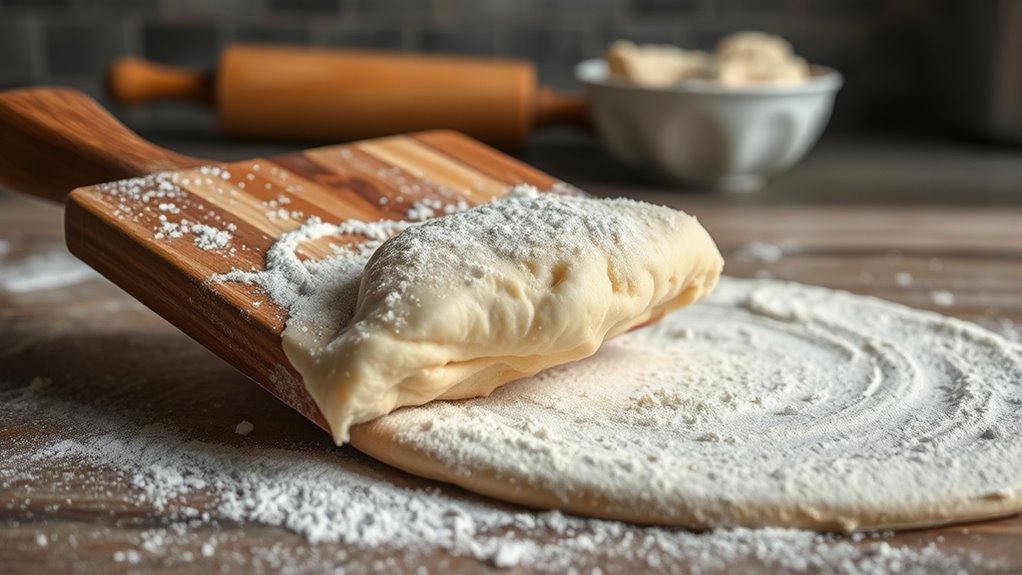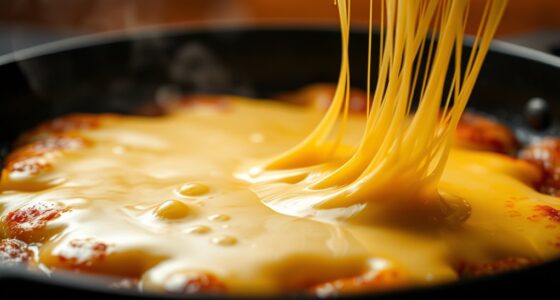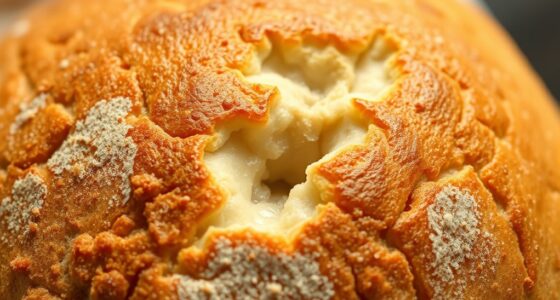If your dough sticks to the peel, start by ensuring your oven and baking surface are preheated to 475°F–500°F, as a hot surface helps dough slide easily. Dust your peel generously with flour, semolina, or cornmeal to create a barrier. Gently shake the peel to check if the dough moves freely, and add more dusting if needed. For more tips on perfect launches, keep exploring how to troubleshoot sticking issues effectively.
Key Takeaways
- Ensure the oven is preheated to 475°F–500°F and the baking surface is thoroughly heated.
- Generously dust the peel with flour, semolina, or cornmeal to create a barrier against sticking.
- Gently shake or nudge the pizza to see if it moves freely; add more dusting material if needed.
- Check dough hydration; adjust by adding flour or water to achieve a tacky but not overly sticky consistency.
- Use proper handling techniques, avoiding over-handling or excessive moisture, to facilitate smooth launch.

If your dough sticks to the peel, it can feel frustrating and throw off your baking rhythm. But don’t worry—this issue often has simple solutions rooted in understanding your dough’s characteristics and your oven’s settings. One key factor is oven temperature. If the oven isn’t hot enough, it can make the dough more prone to sticking because the crust doesn’t set quickly enough to release easily. Guarantee your oven reaches the best temperature for baking pizza—usually between 475°F and 500°F. A properly preheated oven helps the dough form a crust faster, reducing the chance of sticking as you slide it onto the hot baking surface. Also, make sure your baking surface, whether it’s a pizza stone or steel, is adequately preheated. This creates a seamless changeover from peel to oven, helping the dough glide smoothly.
Another critical element is dough hydration. If your dough has too much water, it becomes softer and more elastic, increasing the likelihood of sticking to the peel. On the flip side, dough that’s too dry may crack or tear when you try to launch it. Finding the right balance in dough hydration is essential. Typically, a hydration level of around 60-65% works well for pizza dough, giving it enough moisture to be pliable but not sticky. To check if your dough’s hydration is on point, feel the dough’s consistency—should be tacky but not overly sticky. If it’s sticking excessively, try adding a little flour during kneading, but do so sparingly to avoid making the dough too stiff. Conversely, if the dough feels dry, incorporate small amounts of water gradually until it reaches the desired tackiness.
Additionally, proper handling techniques can make a huge difference. Dust your peel generously with flour, semolina, or cornmeal before placing the dough on it. This layer acts as a barrier, reducing sticking and helping the dough slide off easily. When you’re ready to launch, gently shake the peel to see if the dough moves freely; if it resists, add a bit more flour or semolina underneath.
Frequently Asked Questions
Can I Reuse Dough That Sticks to the Peel?
Yes, you can salvage dough that sticks to the peel if it’s still workable. Gently flour the dough and peel to prevent further sticking, then carefully lift and reposition it. To avoid future issues, use sticking prevention techniques like dusting the peel with flour or cornmeal, ensuring the dough is not too wet, and working quickly. These steps help keep your dough manageable and prevent waste.
What Types of Flour Prevent Sticking Best?
Using flour with a high gluten content is your best bet to prevent sticking; it creates a resilient crust that fights off sticking like a superhero. For ideal results, dust your peel generously with all-purpose or bread flour, which have enough gluten to keep the dough from sticking without overdoing it. Avoid low-protein flours like cake or pastry flour, as they lack the structure needed for easy release.
How Does Humidity Affect Dough Sticking?
Humidity impact can make dough stickier because higher moisture levels cause the dough to absorb more moisture from the air. When humidity is high, your dough may become overly moist, increasing the chances of sticking to the peel. To counter this, you should adjust your flour amount or work quickly to reduce moisture absorption. Keeping your environment cooler and drier helps prevent the dough from becoming too sticky during handling.
Is It Better to Use a Wooden or Metal Peel?
You should choose a wooden peel over a metal one for better results. Wooden peels are gentler on dough and help prevent sticking, making it easier to slide your pizza onto the oven. Metal peels are more durable and slide smoothly but can cause sticking if not used carefully. For ease and to reduce sticking, a wooden peel is typically better, especially if you’re still perfecting your technique.
How Long Should I Let Dough Rest Before Launching?
You should let your dough rest for at least 30 minutes to improve dough conditioning and temperature control. During this time, the gluten relaxes, making it easier to launch, and the dough reaches a consistent temperature, reducing sticking. Keep it covered, and avoid over-proofing. Properly rested dough will be more pliable and less sticky, helping you slide it onto the oven or peel smoothly without sticking.
Conclusion
Don’t despair if dough detours on your peel. With a little patience and practice, you’ll perfect your peel-popping procedure. Remember, flour fosters freedom from sticking, and a gentle, guiding hand gets the dough going. Keep experimenting, stay persistent, and soon you’ll be a pro at launching pizzas perfectly. So, stay steady, smooth out setbacks, and savor the satisfying success of a seamless launch—soon, sticking will be a thing of the past!









